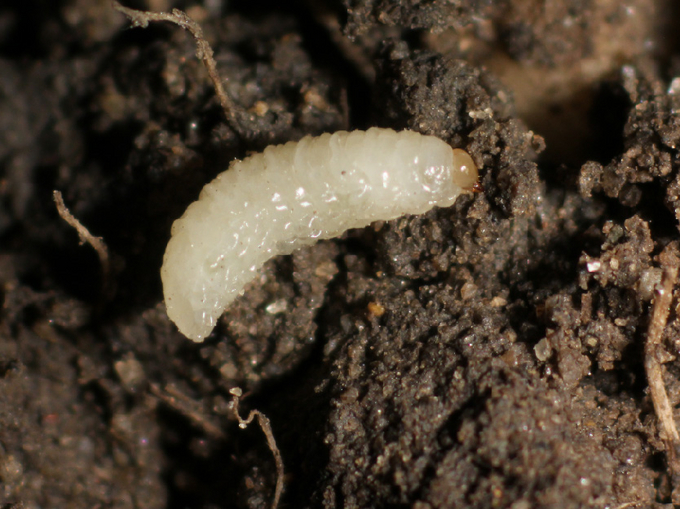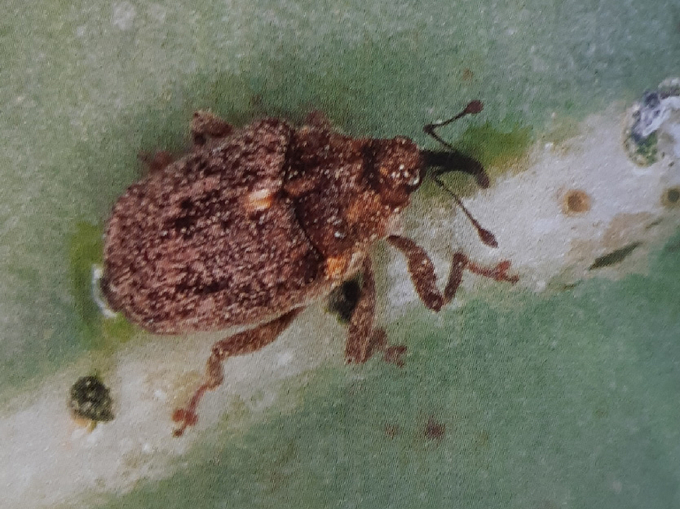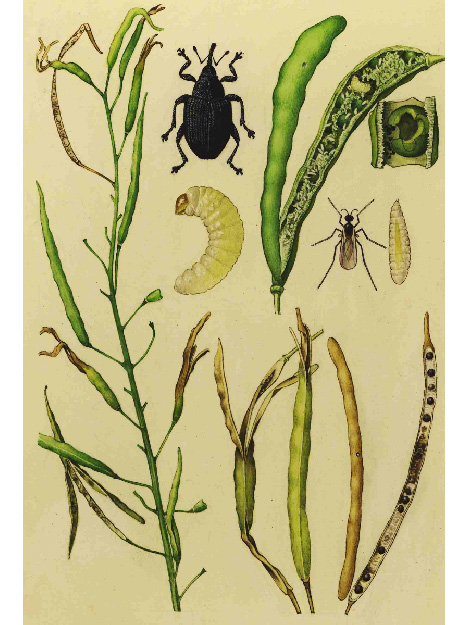Cabbage stem weevil and cabbage seed weevil
Ceutorhynchus pallidactylus, Ceutorhynchus assimilis
Appearance
The head of the small cabbage weevil (Ceutorhynchus pallidactylus Marsham, 1802, formerly C. quadridens Panzer, 1795), which measures only 2-3 mm, is, as is typical for weevils, elongated in the shape of a proboscis and has knobbed, seven-limbed antennae. Its dark brown body surface is heavily hardened (sclerotised) and irregularly covered with brownish scale hairs in various shades. This gives it a grey-spotted appearance, which is why it is also known as the spotted cabbage weevil. It can be easily distinguished from other species, such as the closely related rape stem weevil, by the presence of a yellow-brown spot behind the neck shield and red-brown foot limbs.
The larvae, which are up to 5 mm long, are whitish in colour, have a light brown head capsule and are legless.
Biology
There are several species of weevils whose larvae live on a wide variety of cruciferous plants. The most common is the cabbage stem weevil.
In addition, the large cabbage stem weevil or rape stem weevil(Ceutorhynchus napi Gyllenhal, 1837), the cabbage pod weevil(Ceutorhynchus obstrictus Marsham, 1802; formerly C.assimilis Paykull, 1800) and the cabbage weevil(Ceutorhynchus assimilis Paykull, 1792, formerly C. pleurostigma Marsham, 1802). The black cabbage stem weevil(Ceutorhynchus picitarsis Gyllenhal, 1837) is also occasionally mentioned. The lifestyle of these species is similar and they only produce one generation per year.
Small cabbage stem weevil
The adult beetles overwinter in sheltered places, such as in the ground litter of bushes, forest edges or hedges. As soon as the air temperature exceeds 12 °C in March, the females begin to fly and seek out their host plants. After about ten days of maturation feeding, holes are gnawed into the near-stem area of leaf veins to lay eggs. Three to four eggs are then laid in each of these cavities. The tissue then heals again. The transparent eggs are completely concealed in the leaf tissue. Each female lays an average of 150 eggs in this way.
After about six days, the larvae hatch and begin to feed inside the stems. They create feeding tunnels in which they slowly work their way towards the ground. The larvae leave their host plant and pupate in a small, self-dug burrow. In June of the same year, they hatch into beetles, which do not reproduce until the following year. While the main mass of weevil larvae develops on oilseed rape in early spring, stragglers can be found somewhat later in the year on cabbage, radishes or horseradish.
Cabbage pod weevil
This weevil species only flies from the flowering time of oilseed rape. It lays its eggs in the pods of cruciferous plants after a ripening feed. The larvae feed on the seeds and, after developing, bore their way out of the pod wall to pupate in the soil. After hatching in summer, the beetles feed on flowering cruciferous plants before going to their winter quarters. The cabbage pod weevil favours infestation by the cabbage pod gall midge(Dasineura brassicae).
Large cabbage stem weevil
In contrast, the cabbage stem weevil flies a few days earlier and lays one egg in each feeding hole in the stem of its host plant, not in the leaf stalks. When laying the eggs, each female secretes a substance that stimulates the plant tissue to proliferate. The beetles only hatch after overwintering and not in early summer.
Cabbage gall weevil
Unlike its related species, the larvae of the cabbage gall weevil live in pea-sized growths (galls) in the root collar or on the main root of young plants. The beetle usually overwinters here and lays its eggs in the spring after maturing. However, it is also said that the females lay eggs in the autumn so that the larvae overwinter in their galls. Arrow cress is also a possible alternative host.
Black cabbage stem weevil
The black cabbage stem weevil begins laying its eggs in autumn. The damage to the plants is caused by the larvae over the winter months.
Damage symptoms
The feeding tunnels of the larvae of the small cabbage shoot weevil are found in April and May in the petioles and stems of cabbage vegetables, rarely also in the bulb of radish. In June, the adult beetles are often found on young heart leaves that are still exposed or also on the leaf veins of older leaves, where they cause pit-shaped feeding holes. Pods damaged by the cabbage pod weevil have bright spots and pinhead-sized boring holes.
Yield losses from these weevils can be 20-30%, depending on the weevil species and the condition of the crop. Severe damage can occur, especially to cabbage seed bearers, after spring planting. The puncture site caused by the oviposition as well as the borehole of the larvae can also serve as entry ports into the plant for other pathogens such as fungi or bacteria.
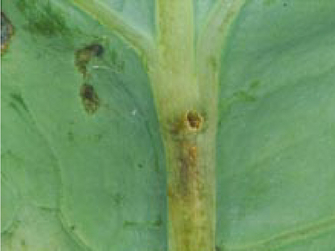
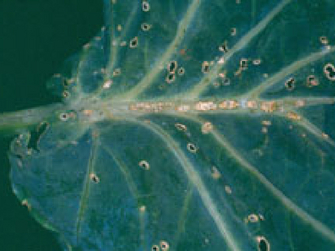

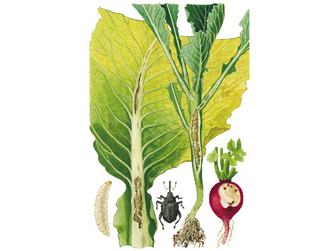
Host plants
Cabbage shoot weevils feed on a wide variety of cruciferous plants (canola, cabbage, mustard, radish, turnip, radish, garden cress, and many others). However, which ones are attacked depends primarily on their availability: for example, in early spring after overwintering, mainly winter rape and cabbage seed bearers are available. Plants such as cabbage vegetables, horseradish or radishes, on the other hand, are only attacked later by "stragglers".
Prevention and control
- Chemical control of adult beetles is possible with products against the cabbage stem weevil/rape stem weevil/cabbage pod weevil or biting insects (see list of plant protection products authorised in Austria)
- The best time for application is in early spring as soon as the first beetles fly but have not yet laid eggs. Eggs or larvae in the rapeseed stalks are very well protected and cannot be chemically controlled. If the treatment is carried out too early, a second treatment may have to be carried out.
- Yellow traps are used to determine when the beetles start to fly:
- Set up at field edges and in the crop and check daily for beetles.
- It is recommended to add a few drops of washing-up liquid and spirit - this reduces freezing on cold nights.
- Observe threshold values for spraying measures.
- As a preventative measure, cultivate cabbage as far away from oilseed rape as possible and choose a later cultivation time to avoid the flight period of the beetles.
- When planting seed carriers in early spring, covering them with close-meshed fly screen or fleece has proven to prevent the beetles from flying in.
- Cultivation of early-shooting rapeseed varieties.
- Promote rapeseed development in the juvenile stage.
Last updated: 11.10.2024
automatically translated
